 |
| Search |
|
|
UmpireHockey.com
is published by
Cris Maloney.

|
 |
Stories from the Field
ORIGINALLY PUBLISHED 12 SEPT 2006: In an effort to find a way to help hockey programs that are relying on a grass competition surface, UmpireHockey.com found a superior grass surface and interviewed its lead groundskeeper.
The competition surface selected is [was] at Rider University, Lawrenceville, NJ. As the photos in this article show, it is one of the few grass surfaces in the United States—this side of a golf green—worthy of selection.
A quick visual measure laymen can use to determine if a hockey surface has been properly prepared is being able to see the shoes of the competitors as they run across the playing surface. If the grass is up to an athlete's ankles, you're not watching a hockey game.
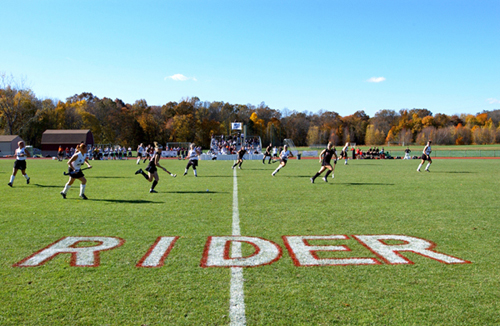 |
| Game day on Rider University's grass competition surface. Cutting the grass to a maximum height of one inch (1") and periodic rolling helps Rider University provide a smooth surface that ensures safety and enhances skillful play. Photo courtesy of Peter G. Borg. |
Larry Toth, Leadperson, Campus Grounds and Athletic Facilities for Rider University, demonstrated his passion for taking care of the university's game fields throughout our interview. In fact, despite our friendly reminders that we really only cared about the hockey surface, Toth couldn't keep from mentioning the other competition sites that he and his crew care for on the Rider campus. He clearly takes pride in the results—and with good reason.
GRASS CUTTING 101
The grass is allowed to grow to about 3 inches in height during the off-season. As the season approaches, the grass is cut to competition height in stages so as not to stress the plant. Toth said with about two weeks to go before the season he starts taking an additional half-inch (1/2") off the grass height. There are four to five days between each stage.
Once the competition season is about to get underway, the grass on Rider University's hockey surface is down to the one-inch (1") height required for college-level hockey competitions.
It takes a little over an hour for Toth to cut the grass on the competition surface.
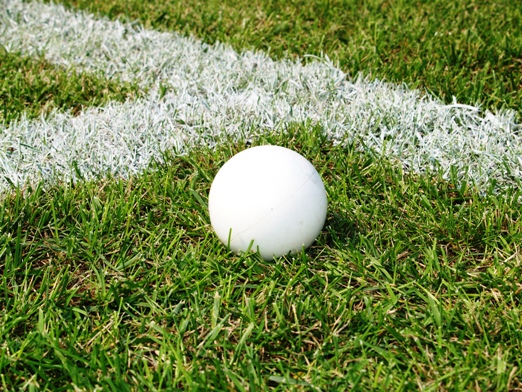 |
| This hockey ball is on Rider University's hockey competition surface. |
The machine used to cut the grass on the Rider University competition surface is a Toro Ground Master 345.
Toth suggests that surfaces for athletic competitions be cut in alternating directions. He cuts down the length of the surface one day, from end line to end line, and then, the next time he cuts the grass, he cuts from side line to side line.
NOTE: Toth uses a grinding wheel to keep the cutting blades sharp. Experts agree that blade sharpening is an important standard part of quality grass cutting operations.
 |
| Larry Toth, Leadperson, Rider University Campus Grounds and Athletic Facilites onboard the university's Toro Ground Master 345 with PeCo clippings vac. Toth likes to remove the clippings to keep thatch build-up to a minimum. Photo courtesy of Peter G. Borg. |
CUTTING TO ONE INCH
We asked if any special aftermarket engineering is needed to get this piece of equipment to cut grass to a one-inch height. Toth's answer was, "No."
The deck, which houses cutting blades, is held at the desired height by the deck wheels.
Adding or removing spacers, which are standard factory equipment, on the shafts of the deck wheels adjusts the height of the cut.
"You prop up the deck, pull a pin on the shaft, move the spacer, and your done. I can adjust the height of the deck in less than five minutes," said Toth. [ED: We got the impression that if you had never done it before it might take about ten minutes.]
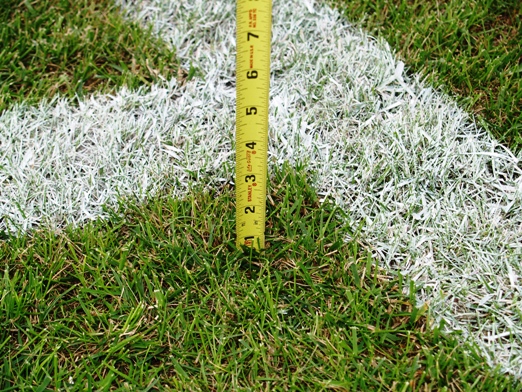 |
| The grass on Rider University's hockey surface is cut to one-inch (1") the day before each game. According to the rule modifications published by the National Federation of State High School Associations, grass on a high school hockey surface should be cut so it does not exceed 1½ inches. |
CUTTING FREQUENCY
The grass is typically cut the day before a game. Toth told us that he tries to cut the grass two to three times a week during the season.
SURFACE CARE
The surface is rolled with a five-foot long, fifteen-inch diameter, water-filled roller. Toth estimates the roller weighs about 650 pounds when filled. What Toth described as a "small lawn tractor" is used to pull the roller. [ED: I would describe it as a large lawn tractor though it is much smaller than the Toro Ground Master shown in the photograph above.]
It takes about an hour for Toth to roll the competition surface.
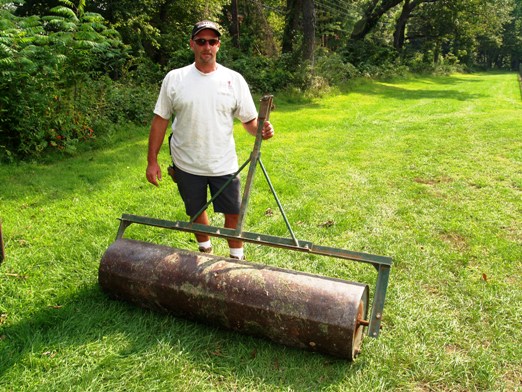 |
| Toth lifts the hitch on the water-filled field roller he uses once a week to keep Rider University's grass hockey surface smooth. Toth estimates that when the roller is filled with water, it weighs about 650 pounds. |
Toth emphasized the importance of rolling by describing how during the winter months and the spring thaw the ground contracts and expands and does so unevenly and in patches.
In the spring, Toth rolls the surface once and then "on occasion" during the summer. During the season, it's rolled once a week.
The best time to roll the surface is when the ground is soft, for example, after it rains. "It can't be so soft that the tractor would leave ruts but it doesn't do any good to roll it when the ground is hard," said Toth.
As with his cutting practice, Toth alternates the direction in which he rolls the surface.
IRRIGATION AND FEEDING
When it doesn't rain, the grass is watered for about thirty minutes every other day.
In the fall, about a week after the last game, the competition surface is aerated and slice seeded. Toth said if you don't slice seed the game field, then surface seeding should be done on a regular basis—even during the season. He just tosses seed down knowing that some will germinate. Toth seed of choice is Turf Type Tall Fescue.
In the spring and summer the field is treated once with starter fertilizer, once to control grab grass, and once to protect against grubs and other pests.
Toth hires the experts at Tru-Green to handle aerating, fertilizing and slice seeding.
WHAT'S A HIGH SCHOOL TO DO?
Very often, high school athletes are forced to play on surfaces that look more like a cow pasture than a competition surface.
One thing that cannot be ignored is that a hockey surface with long grass (grass exceeding 2") is simply not being prepared for a competition.
If groundkeepers haven't moved the spacers on their mower's cutting decks, the grass will be too high.
[ED: My observation of local grass hockey surfaces is that the grass on the competition surface is cut to the exact same height as the surrounding non-competition areas. This suggests that the deck spacers are NOT being changed when the mower reaches the hockey surface. If the deck isn't adjusted, the grass on the hockey surface is never going to be an appropriate height.
The most important thing high schools can do is the easist. Cut the grass to a maximum of 1.5 inches!
If the school can do nothing else recommended in this article, they can, at the very least, cut the grass on their hockey surface to 1.5 inches!
The second most important thing a high school can do is ROLL their hockey surface.
Rolling is not a high-tech operation and rollers are not expensive.
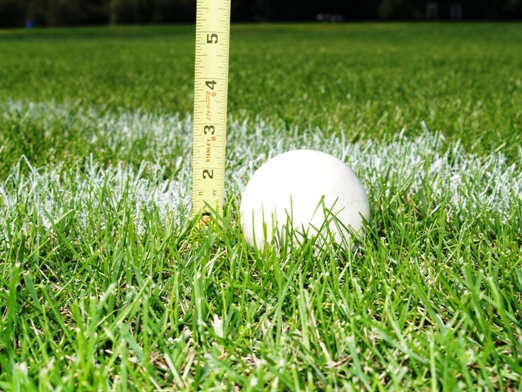 |
| This hockey ball is on a competition surface cut for high school hockey. Many blades exceed the maximum allowable height of 1½ inches and, in fact, many are almost 2" tall. A surface prepared with grass at this length will negatively impact skillful play and can't be reasonably be called a competition surface. |
High schools may not be able to remove grass clippings as they cut their competition surfaces but by following quality cutting practices, relatively frequent cuts with sharp blades, they can keep the impact of thatch to a minimum.
High schools may not be able to slice seed their hockey surface every year but they can certainly surface seed. Adding a little top soil to the areas that need seeding will help smooth the surface and will help the seeds to germinate.
Copyright © 2002-
UmpireHockey.com
Top of Page
|
|
 |
Stories from the Field
Latest Headlines
|

|